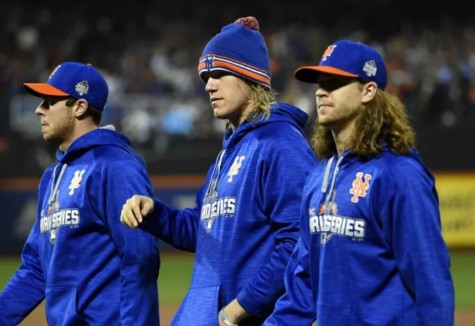
The Mets’ young core is giving the fans hope for a sustained run of success. But the mere presence of these budding superstars, in a bizarre way, holds them back as they try to supplement this core. Every team wants to break up our top young rotation.
Other teams ignore our silver, simply because they see we also have gold. Then they accept offers of silver, even bronze, elsewhere
This has bothered me for a long time, and the feeling resurfaced today. By now, you’ve probably heard that superstar closer Aroldis Chapman is coming to New York.
Yes, THAT Aroldis Chapman. The Cuban lefty whose 105 MPH missile makes the Mets’ young “fireballers” look like they’re lobbing water balloons.
But not THAT New York baseball team. Aroldis Chapman is not coming to Queens, where he’d fill what might be the Mets’ biggest hole: an elite relief pitcher to pair with Jeurys Familia in the bullpen. Chapman will not be giving the Mets a multi-headed bullpen monster like the one the Royals showed off en route to their recent World Series title at our expense; he’ll be adding to the one the Yankees have already built across town. Chapman, Dellin Betances, and Andrew Miller (it sure looks like we should have signed him last winter) will give the Yankees a trio of nearly unhittable arms out of the pen. The Yankees won’t have to worry when one of those guys needs a day off. If they can get the ball to their bullpen with a lead, even if they can’t get it straight to the closer, the Yanks will be just fine.
The Mets could have used an elite reliever, and Aroldis Chapman fits that bill. Furthermore, he doesn’t come attached with a long-term commitment— while most teams would rather acquire a guy under “control,” the Mets appear to almost exclusively want guys on one-year deals, which is why they’ll happily shell out over $22 Million to Addison Reed, Jerry Blevins, Alejandro De Aza and Bartolo Colon in 2016 but have balked at multi-year deals for the likes of Darren O’Day, Ryan Madson and Joakim Soria in the bullpen or Yoenis Cespedes, Justin Upton, and Gerardo Parra in the outfield. Chapman, like most players the Mets have brought in, is a free agent after the season.
The Yankees got Chapman while managing to hold on to all of their top prospects. The names you may have heard— Judge, Bird, Mateo, Severino— are all staying put. The Yankees gave up their #6 and #10 prospects, along with two guys outside their top 30.
The Mets reportedly discussed Chapman at the trade deadline, so he was surely at least on their radar at some point. If the Yankees took a guy who had been on the Mets’ list, it wouldn’t be the first time. Look at Starlin Castro, who was connected to the Mets for a couple years in rumors and hypothetical mutually beneficial trade scenarios. The Mets were starting at a steep price tag of at least one of their young aces (Steven Matz, Noah Syndergaard, Jacob deGrom, Zack Wheeler and Matt Harvey) and potentially more. The Yankees got him for a pretty good 28 year-old pitcher with little upside. A similar outcome took place with Didi Gregorius: the Mets balked at the high price tag, but the Yankees scored a discount by landing Didi in a three-team trade that cost them a 26 year-old with a 3.80 ERA.
For the Mets, a comparable Chapman package to the one the Mets gave up would be: Matt Reynolds, Wuilmer Becerra, Akeel Morris and Max Wotell. I have been generous, even, listing a probably-more-valuable package to account for my admittedly lacking knowledge of the details of the Yankees’ farm system. What I am quite confident of, however, is the likelihood that if the Mets engaged the Reds in trade talks— even after the legal troubles I will address at the end of this article— the players being floated about would have been the young aces and guys like Brandon Nimmo, Amed Rosario and Dom Smith, rather than guys like Reynolds and Morris (he of the 67.50 MLB ERA).
The Mets have a set of absolute gems at the top of their trade-value pyramid. They have a billion-dollar rotation making peanuts (in addition to Michael Conforto). Is there a drop-off after that? Sure, how could there not be, with such amazing young talent at the front of the pack? But the continued pattern— at least one that certainly appears to be the case when we hear about guys other teams are asking for in talks with us, then see the guys they ultimately accept from other squads— appears to indicate that Sandy Alderson’s fellow GMs are expecting him to give a ton simply because he has a ton to give, and are turning up their noses at some very solid alternatives to the untouchable— deservedly so— pieces. The Yankees can trade guys of value on par with Nimmo or even Reynolds and Morris because they don’t have guys like Syndergaard.
What still remains odd, then, is the quality of the players the Yankees gave up relative to their OWN system. It is somewhat understandable that a team might accept Judge from the Yankees when they’d want Thor from the Mets— the Yankees don’t have a guy like Thor to give. But, unlike in negotiations with the Mets, teams appear to be willing to take packages of lesser minor-leaguers when the Yankees hold firm on keeping their own top guys. And if anything, it should be the other way around. The Mets’ 11th-best prospect is probably a good amount better than the Yankees’ 6th-best guy, but Brian Cashman is having a much easier time getting teams to give up great players than Sandy Alderson, despite having inferior chips to trade.
Now, I am not praising Cashman at Sandy’s expense. I happen to think Cashman is a mediocre GM blessed with an aggressive and extremely wealthy ownership group. Sandy has made his share of terrific trades, such as the Beltran-Wheeler deal or the Dickey-Syndergaard/d’Arnaud/Bucerra pillaging. The swap of Marlon Byrd for Dilson Herrera should pay off soon. But what do these deals have in common? Sandy is getting prospects for established MLB studs, and is fortunately (but to his credit) hitting on these prospects rather than getting a haul of busts. That’s all good and well, but the Mets are at the point where they should put a twist on that model, and see if they can move prospects for elite MLB talent— without emptying out the farm system. The Yankees have routinely swung such trades, and while I’m never shy to criticize the Mets’ front office, it seems like much of the issue lies with the attitudes of the people across the table from Sandy when he and his counterparts sit down to negotiate.
I would be remiss in not acknowledging Aroldis Chapman’s current legal troubles. These troubles certainly hurt his trade value, because he could get suspended— and they hurt his value in the eyes of many fans who are put off by his possible character issues. But it seems unlikely he’d get a massive suspension (if he did, the Yankees might get another year of him due to service time rules, if not, they’ll get a draft pick if they want to let him walk after the season). So the Yankees will have a superstar for nearly the entire season and the postseason, and it doesn’t seem like they gave up much to get him— certainly not as much as the package the Mets would have needed to send to Cincinnati to get the same player.
While these situations are all unique (the Didi deal was a three-teamer, and Chapman’s situation is certainly cloudy) and trading is not based on a mathematical “value” rating like you might see in a video game, it doesn’t seem like the Mets are being given fair treatment when they attempt to play the trade market. As players shed the “prospect” label— Harvey and deGrom already have, the other starters will soon— other teams may stop trying to steal our aces at a “prospect” price and begin to appreciate the considerable value of the next tier— Nimmo, Smith and the like— of top Met prospects when the Mets show up to hammer out a trade.
But the irrational negotiating stance our fellow teams appear to be taking with us is as frustrating as any internal payroll gripe.














